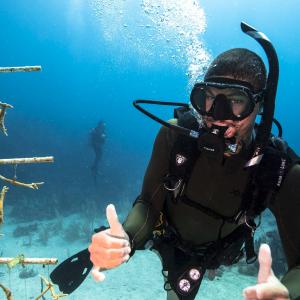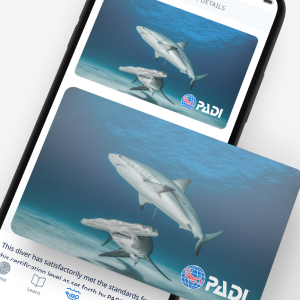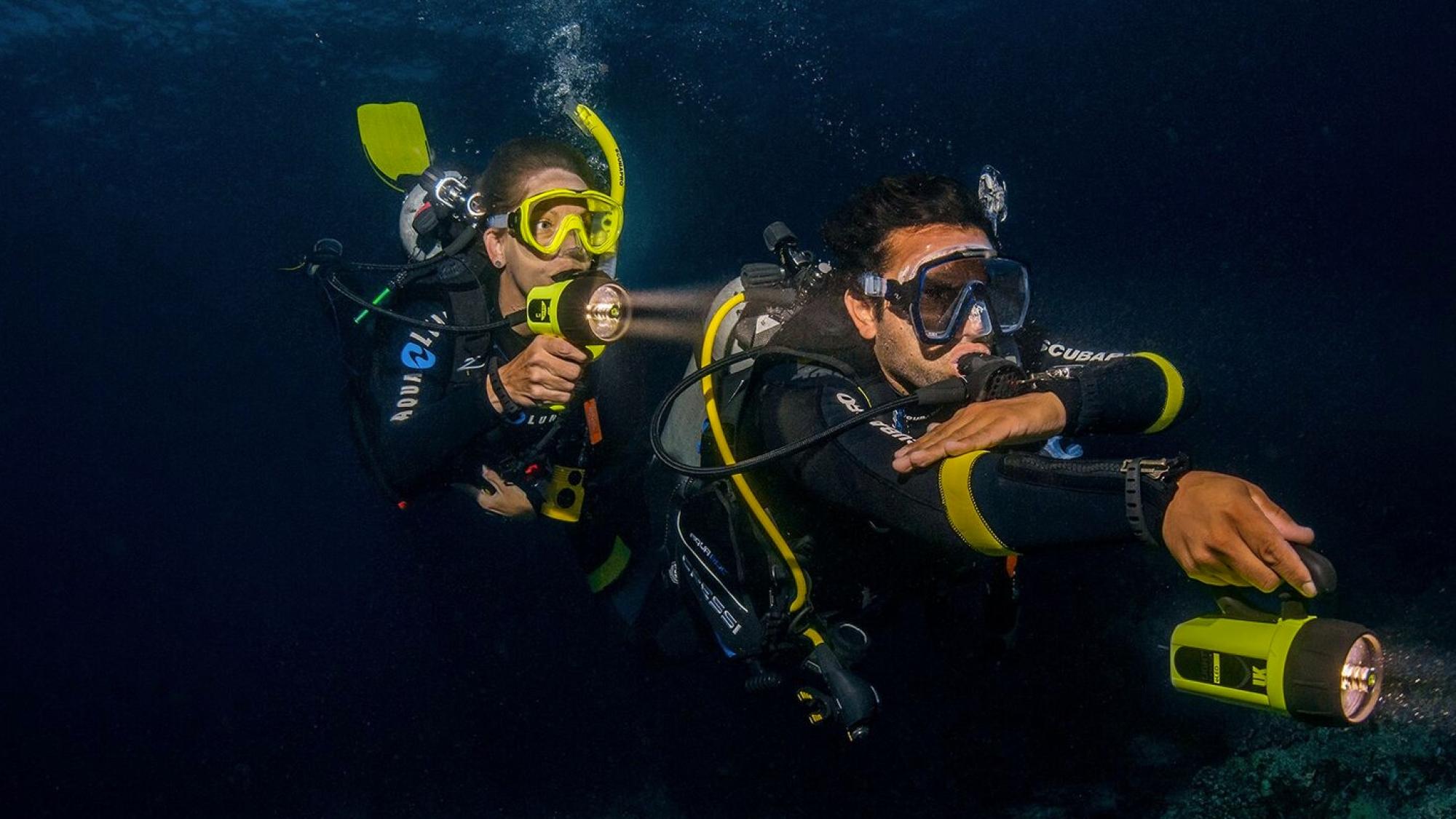คำอธิบาย
เป็นที่ชัดเจนว่าไฟฉายดำน้ำมีความจำเป็นในการดำน้ำสคูบาในตอนกลางคืน เพื่อช่วยให้คุณสามารถนำทาง ดูมาตรวัดต่าง ๆ และสังเกตสิ่งมีชีวิตในน้ำที่น่าสนใจได้ แต่อย่างไรก็ตาม ก็เป็นความคิดที่ดีที่จะพกไฟฉายติดตัวไปในระหว่างวันเพื่อส่องดูภายในซากเรือ ดูใต้ขอบหินและส่องไฟในถ้ำโพรง คุณจะใช้มันในการผจญภัยดำน้ำทั้งหมดของคุณเพื่อดูรอยแตกและรอยแยกที่สิ่งมีชีวิตขี้อายซ่อนอยู่ เยี่ยมชมศูนย์ดำน้ำหรือรีสอร์ท PADI ของคุณ เพื่อรับคำแนะนำเกี่ยวกับไฟฉายดำน้ำ
Standard Features
- เคสแข็งแรงทนทานต่อน้ำและแรงดัน
- สวิตช์ที่เชื่อถือได้ซึ่งเปิดและปิดง่ายแม้จะสวมถุงมือก็ตาม
- ซีลโอริงกันน้ำที่ให้คุณเข้าถึงแบตเตอรี่และหลอดไฟได้
- ไฟฉายหลายกระบอกมาพร้อมกับสายคล้องข้อมือหรือคลิปหนีบ ดังนั้นแม้ว่าคุณปล่อยไฟฉายโดยไม่ได้ตั้งใจ คุณก็ยังสามารถดึงกลับคืนมาได้
สไตล์ไฟฉายดำน้ำ
ไฟฉายหลักโดยทั่วไปจะเป็นรุ่นใหญ่ที่มีลำแสงกว้างและทรงพลัง แต่คุณก็ยังสามารถพบไฟฉายเล็ก ๆ ที่สว่างมากได้เช่นกัน ไฟสำรองมักจะมีขนาดเล็กกว่าและมีลำแสงที่แคบกว่า ซึ่งเป็นสิ่งที่คุณอาจต้องพกติดตัวทุกครั้งที่ดำน้ำและแน่นอนว่ารวมถึงในการดำน้ำตอนกลางคืนด้วย ดังนั้นคุณจะได้ไม่ต้องดำน้ำโดยไม่มีไฟฉายสำรองหากไฟฉายหลักของคุณดับ
Optional Features
- แบตเตอรี่มีทั้งแบบที่สามารถชาร์จไฟได้และแบบใช้แล้วทิ้ง
- ในช่วงแรก ระบบชาร์จไฟใหม่จะมีราคาแพงกว่า แต่จะคุ้มทุนหากคุณใช้ไฟฉายดำน้ำบ่อยครั้งและเป็นตัวเลือกที่ดีกว่าที่เป็นมิตรต่อสิ่งแวดล้อม
- แบตเตอรี่แบบใช้แล้วทิ้งคุณภาพสูงเหมาะอย่างยิ่งสำหรับไฟฉายดำน้ำที่คุณใช้เพียงครั้งคราวเท่านั้น
- หลอดไฟและพลังงานแบตเตอรี่มีอิทธิพลต่อความสว่างของแสง
- หลอดไฟฮาโลเจนและซีนอนให้แสงสว่างแต่กินพลังงานแบตเตอรี่มาก
- หลอดไฟ LED (ไดโอดเปล่งแสง) มีความทนทานสูงและประหยัดพลังงาน
- หลอดไฟ HID (high intensity discharge) ให้แสงสว่างมากกว่าเป็นสองเท่าจากแบตเตอรี่เพียงครึ่งเดียว
- ด้ามจับหรือตัวยึดช่วยให้คุณถือไฟได้อย่างสะดวกสบาย ไม่ว่าจะไว้ในมือหรือติดไว้กับอุปกรณ์ดำน้ำของคุณ ไฟฉายเล็ก ๆ บางแบบก็สามารถติดไว้บนหน้ากาก ข้อมือ สายท่อต่าง ๆ ไฟแฟลชกล้องหรือที่ใด ๆ ก็ได้ที่คุณนึกถึงเพื่อติดไฟ
- ไฟฉายบางดวงมีโหมดพลังงานหลายโหมดเพื่อให้ใช้พลังงานแบตเตอรี่ได้อย่างคุ้มค่าที่สุด
- สำหรับการดำน้ำตอนกลางคืน นักดำน้ำยังใช้แท่งเรืองแสงเคมี ไฟแฟลชใต้น้ำหรือไฟเครื่องหมายขนาดเล็กอื่น ๆ เพื่อความปลอดภัย
How to Choose
- ตัดสินใจว่าคุณน่าจะใช้ไฟฉายที่ไหนมากที่สุดและบ่อยแค่ไหน แล้วลองคิดดูว่าคุณจะดูแลแบตเตอรี่ได้ดีแค่ไหน
- หยิบและพกพาไฟฉายสองสามกระบอกไปด้วย จะดีที่สุดหากมีแบตเตอรี่ในตัว แต่อย่าลืมว่าเมื่ออยู่ในน้ำจะเบากว่า
- ประเมินที่จับให้เหมาะกับมือของคุณ
- ทดสอบว่าคุณสามารถเปิดและปิดได้ง่ายแค่ไหน
- ลองคิดดูว่าการถือไฟฉายไว้สำหรับการดำน้ำตอนกลางคืนนานหนึ่งชั่วโมงจะสบายมือแค่ไหน
- พิจารณาคุณสมบัติพิเศษอื่น ๆ เช่น สายคล้องที่แถมมาหรือโหมดพลังงานหลายโหมด แล้วจึงเลือกไฟที่ดีที่สุดตามความต้องการในการดำน้ำของคุณ ขอความช่วยเหลือจากมืออาชีพด้านการดำน้ำที่ศูนย์ดำน้ำหรือรีสอร์ท PADI ของคุณ เลือกไฟฉายที่ดี คุณจะไม่เสียใจ
Maintenance
ให้เทน้ำออกจากกระเป๋าดำน้ำของคุณแล้วล้างหลังการใช้งานทุกครั้ง และปล่อยให้แห้งสนิทก่อนจัดเก็บ







 เศษซากทะเล
เศษซากทะเล
 ยพันธุ์ฉลามและกระเบนที่เสี่ยงต่อการสูญพันธ์ุ
ยพันธุ์ฉลามและกระเบนที่เสี่ยงต่อการสูญพันธ์ุ
 Adopt The Blue
Adopt The Blue













